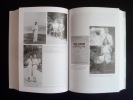20 books for « lispector clarice »Edit
-
Latest
Last month (1)
Last week (1)
-
Century
20th (10)
21st (1)
-
Topics
Biography (1)
Brazil (1)
Literature (3)
Newspapers press (1)
Translation (1)
-
Countries
France (14)
Switzerland (6)
-
Syndicate
ILAB (9)
SLAM (9)
Liens de famille
Femmes -des- (12/1989)
LIVRE A L’ETAT DE NEUF. EXPEDIE SOUS 3 JOURS OUVRES. NUMERO DE SUIVI COMMUNIQUE AVANT ENVOI, EMBALLAGE RENFORCE. EAN:9782721003843
Où étais-tu pendant la nuit ?
Des Femmes. 1985. In-12. Broché. Etat d'usage, Coins frottés, Dos satisfaisant, Intérieur frais. 168 pages.. . . . Classification Dewey : 860-Littératures espagnole et portugaise
Nouvelles. Traduit du brésilien par Geneviève Leibrich et Nicole Biros. Classification Dewey : 860-Littératures espagnole et portugaise
Agua viva. Suivi d'un entretien inédit de l'autrice
Femmes -des- (10/2024)
LIVRE A L’ETAT DE NEUF. EXPEDIE SOUS 3 JOURS OUVRES. NUMERO DE SUIVI COMMUNIQUE AVANT ENVOI, EMBALLAGE RENFORCE. EAN:9782721013507
Près du coeur sauvage
Femmes -des- (1/2019)
LIVRE A L’ETAT DE NEUF. EXPEDIE SOUS 3 JOURS OUVRES. NUMERO DE SUIVI COMMUNIQUE AVANT ENVOI, EMBALLAGE RENFORCE. EAN:9782721006974
De natura florum
Femmes -des- (11/2023)
LIVRE A L’ETAT DE NEUF. EXPEDIE SOUS 3 JOURS OUVRES. NUMERO DE SUIVI COMMUNIQUE AVANT ENVOI, EMBALLAGE RENFORCE. EAN:9782721012357
Complete Stories
Penguin Books UK (8/2015)
LIVRE A L’ETAT DE NEUF. EXPEDIE SOUS 3 JOURS OUVRES. NUMERO DE SUIVI COMMUNIQUE AVANT ENVOI, EMBALLAGE RENFORCE. EAN:9780141197388
Liens de famille. Contes et nouvelles
P., Éditions Des femmes - Antoinette Fouque, 1998, pet. in-8, br., 215 pp. (DB25)
Traduit du brésilien par Jacques et Teresa Thiériot.
La femme qui tuait les poissons
Ramsay 1990, broché, 106pp; traduction de Séverine Rosset et Lucia Cherem - très bon état
Près du coeur sauvage. Traduit du brésilien par Regina Helena de Oliveira Machado.
1998 Paris, Editions des Femmes, 1998, petit in 8° broché, 299 pages.
...................... Photos sur demande ..........................


Phone number : 04 77 32 63 69
Lispector Clarice ; Lamaison Didier (Traduction) ; Roitman (Traduction)
Reference : 123116
(2021)
ISBN : 2721009265 9782721009265
Correspondance : Édition intégrale
Des Femmes, coll. « Correspondance » 2021 In-8 broché 24 cm sur 17. 432 pages. Très bon état d’occasion.
300 lettres réunies dont 70 inédites Très bon état d’occasion
Corps séparés - Contes et nouvelles
Des femmes. 1993. In-8. Broché. Bon état, Couv. convenable, Dos satisfaisant, Intérieur frais. 157 pages.. . . . Classification Dewey : 860-Littératures espagnole et portugaise
Traduit du brésilien par Jacques et Teresa Thiériot. Classification Dewey : 860-Littératures espagnole et portugaise
OU ETAIS TU PENDANT LA NUIT
EDITION DES FEMMES. 1974. In-12. Broché. Bon état, Couv. convenable, Dos satisfaisant, Intérieur frais. Non Renseigné. . . . Classification Dewey : 860-Littératures espagnole et portugaise
Traduit du Brésilien par GENEVIEVE LEIBRICH ET NICOLE BIROS. Classification Dewey : 860-Littératures espagnole et portugaise
LA BELLE ET LA BETE SUIVI DE PASSION DES CORPS
EDITION DES FEMMES. 1974. In-12. Broché. Etat d'usage, Couv. convenable, Dos satisfaisant, Intérieur acceptable. 297 pages.. . . . Classification Dewey : 840-Littératures des langues romanes. Littérature française
Traduit du Brésilien par Claude Farny. Relu par Sylvie Durastanti. Classification Dewey : 840-Littératures des langues romanes. Littérature française
LE BATISSEUR DE RUINES. COLLECTION : L'IMAGINAIRE N° 424
GALLIMARD .. 2000.. In-8. Broché. Bon état, Couv. convenable, Dos satisfaisant, Intérieur acceptable. 426 pages.. . . . Classification Dewey : 860-Littératures espagnole et portugaise
Traduit du brésilien par Violante Do Canto. Classification Dewey : 860-Littératures espagnole et portugaise
OU ETAIS-TU PENDANT LA NUIT ?
Des Femmes. 1985. In-12. Broché. Bon état, Couv. légèrement passée, Dos satisfaisant, Intérieur frais. 168 pages. Quelques rousseurs sur le 1er plat et la tranche.. . . . Classification Dewey : 860-Littératures espagnole et portugaise
Nouvelles trad. du brésilien par Geneviève Leibrich et Nicole Biros. Classification Dewey : 860-Littératures espagnole et portugaise
PRES DU COEUR SAUVAGE
PLON. 1954. In-12. Broché. Bon état, Couv. convenable, Dos satisfaisant, Intérieur frais. 253 Pages - Petite étiquette contre collée sur la page de garde. . . . Classification Dewey : 890-Littératures des autres langues
Roman traduit du brésilien par D-T. MOUTONNIER - Préambule par P. MENDES CAMPOS Classification Dewey : 890-Littératures des autres langues
Clarice Lispector - Pourquoi ce monde, suivi d'un entretien entre l'auteur et Antoinette Fouque -
Traduit de l'anglais par Camille Chaplain - Paris : Des Femmes, 2012 - un fort volume 16,8x23,8cm broché sous couverture illustrée à rabats, 441 pages avec un cahier de planches photographiques - Edition originale de la traduction de cette importante biographie - très bon état -
Le BATISSEUR de RUINES
Un ouvrage de 327 pages, format 140 x 205 mm, broché couverture rempliée, publié en 1970, NRF - Gallimard, collection "Le Monde Entier", bon état
Roman traduit du brésilien par Violante do Canto
Phone number : 04 74 33 45 19
La passion selon G.H.
1 vol. in-8 br. 199p. éd. des femmes, 1978. Traduction Claude Farny, préface de Clélia Pisa. Etat : trace de salissures et d'humidité. Intérieur bon, sans fragilité du corps d'ouvrage. Etat moyen
Le Bâtisseurs de ruines. Roman traduit du brésilien.
Editions Gallimard, Paris 1970. In-8 broché, 330 pages avec table.
 Write to the booksellers
Write to the booksellers










